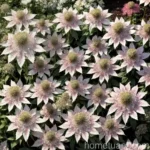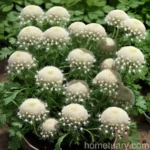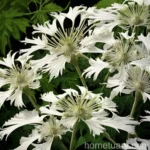What is Plant: Miss Willmott’s Ghost (Eryngium giganteum)
Plants are incredibly diverse organisms that contribute to the health and beauty of our planet. From towering trees to delicate flowers, plants come in all shapes, sizes, and colors. One particular plant that has been captivating gardeners and nature enthusiasts for generations is Miss Willmott’s Ghost (Eryngium giganteum).
Miss Willmott’s Ghost, scientifically known as Eryngium giganteum, is a striking perennial plant that belongs to the Apiaceae family. This unique plant is native to the Caucasus region and has garnered attention for its elegant appearance and resilience. It is also commonly known as giant sea holly, a name derived from its resemblance to the traditional sea holly plant.
In this comprehensive guide, we will delve into the various aspects of Miss Willmott’s Ghost, including its cultivation, uses, care requirements, and much more. Whether you’re a seasoned gardener or a novice plant enthusiast, this article will provide valuable insights into this remarkable plant.
Key Takeaways – Miss Willmott’s Ghost (Eryngium giganteum)
Before we explore the intricate details of Miss Willmott’s Ghost, let’s take a quick look at the key takeaways associated with this captivating plant.
- Common Name: Miss Willmott’s Ghost, Giant Sea Holly
- Scientific Name: Eryngium giganteum
- Plant Type: Perennial
- Family: Apiaceae
- Native Habitat: Caucasus region
- Notable Features: Striking silvery-blue thistle-like flowers, spiky foliage, and drought tolerance
- Cultivation Preferences: Well-draining soil, full sun exposure, and moderate water requirements
Now that we’ve familiarized ourselves with some essential details about Miss Willmott’s Ghost, let’s delve into its cultivation, uses, and care guidelines.
1. Culture
Miss Willmott’s Ghost, Eryngium giganteum, is a plant that carries a certain mystique and allure due to its unique appearance and resilience. Cultivating this fascinating perennial requires a basic understanding of its cultural preferences, including soil, sunlight, water, and fertilizer requirements.
Uses
Before we explore the cultivation specifics, it’s essential to acknowledge the various uses and applications of Miss Willmott’s Ghost. This plant has multifaceted contributions in both natural and cultivated settings, making it a valuable addition to gardens, landscapes, and even floral arrangements. Some common uses of Miss Willmott’s Ghost include:
-
Garden Ornament: The silvery-blue thistle-like flowers and spiky foliage of Miss Willmott’s Ghost make it a captivating addition to ornamental gardens and landscapes. Its unique aesthetic qualities add texture and visual interest to mixed borders, rock gardens, and cottage-style plantings.
-
Floral Arrangements: The striking appearance and long-lasting nature of Miss Willmott’s Ghost make it a popular choice for floral arrangements. The dried flower heads and spiky bracts lend an intriguing texture and color to bouquets and floral displays, adding an ethereal quality to the compositions.
-
Pollinator Support: The nectar-rich flowers of Eryngium giganteum attract various pollinators, including bees, butterflies, and other beneficial insects. By incorporating Miss Willmott’s Ghost into garden landscapes, individuals can actively support the local ecosystem and contribute to the well-being of pollinating species.
-
Medicinal and Folklore Significance: In traditional and herbal medicine, certain species within the Eryngium genus have been utilized for their purported medicinal properties. While specific medicinal uses of Eryngium giganteum may vary, it’s worth exploring the historical folklore and traditional applications associated with this plant.
Water
Sunlight
Fertilizer
Soil
Pruning
Propagation
Container Popularity
Common Diseases
Disease Diagnosis
Common Pests
Botanist’s Tips
Fun Facts
Links to External Resources
- “Miss Willmott’s ghost (Eryngium giganteum) – Royal Horticultural Society (RHS)”: RHS Miss Willmott’s ghost
- “Growing Miss Willmott’s Ghost – The Spruce”: Miss Willmott’s Ghost – The Spruce
- “Eryngium giganteum – Missouri Botanical Garden”: Eryngium giganteum at Missouri Botanical Garden
With our comprehensive exploration of Miss Willmott’s Ghost, we’ve gained valuable insights into the cultivation, uses, and care guidelines for this captivating plant. Whether you’re drawn to its silvery-blue allure, its ability to attract pollinators, or its historical significance, Eryngium giganteum exemplifies the enchanting and diverse nature of plant life. By incorporating these insights into garden landscapes and horticultural endeavors, we can continue to appreciate and celebrate the beauty and resilience of Miss Willmott’s Ghost and other remarkable plant species.















